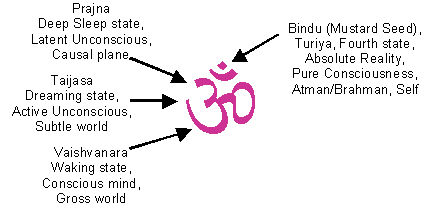Veda in sanskrit (samskritam) language means “to know” or “science” or “wisdom”. The Veda(s) are based on universal laws and principles and contain explicit instructions on the science of “how to live” in joy & peace, in health and wealth.
There are four Veda volumes, Rig, Yajur, Sama and Atharva. Each Veda has 4 sections and the last of these 4 sections is entitled – Upanishads. Vedanta is one of the four sections of the Vedas and its transliterates to “end of the Vedas” or “philosophy of the Vedas”. Vedanta is rooted in the Upanishads, Brahma Sutras, and Bhagavad Gita. There are 108 Upanishads and it has been said that the “juice” of the Vedas is in the Upanishads; and the “juice” of the Upanishads is in the Mandukya Upanishad.
In the Mandukya Upanishad OM (Amen or Amin) Mantra is also suggested as a direct route to Self-realization, Samadhi, or Sahaja Samadhi. The same is noted in the Yoga Sutras, Bhagavad Gita and Brahma Sutras and other important sections of the Vedas.. See illustration at top of this page. The Vedas are complete and should be approached via an integrated practice. For example, the Vedas includes cosmology, physics, remedies and instructions for wellness of body/mind care, such as Ayurveda wisdom. It also includes how-to-live and lifestyle practices that provide for a meaningful and rewarding life. The Yoga section includes techniques and practices applicable to different body/mind constitutions (Prakruti). Those techniques include Self-inquiry best practices, concentration, mastery of lifeforce (pranayama) and 5 senses, meditation and contemplation techniques; and other important practices to gain control of 5 senses, and improve concentration.
To practice one section (vs integrated or all sections) of the Vedas is similar to attempting to drive from New York City to Kansas City without the necessary resources, such as vehicle, gasoline, map, and other necessary items. For instance, since Vedic wisdom arrived in the western hemisphere, Vedanta is being taught as standalone and it has misled people to conclude that it is enough. Vedanta is the philosophy of the Vedas and it will lead to intellectualism and scholarly approach at best as it is missing the techniques and know-how and grow the ego.
The teachings of the Mandukya Upanishad are well worth deep study, discussion, reflection and contemplation. By faithfully and intently engaging these twelve verses, all of the other written and oral teachings can be explored as expansions of the foundation principles and practices encapsulated in this succinct summary. It is not only a most insightful writing, but also a complete outline for sadhana, enlightenment practices.
The OM (Amen or Amin) Mantra is a roadmap of the entire process of sadhana and a most practical tool for Self-Realization. One of the other hundred-plus Upanishads, the Mukti Upanishad (mukti means liberation), explains that for those who are seeking liberation, the understanding and practicing of the principles of the Mandukya Upanishad is sufficient for attaining that realization. Meditating on OM can facilitate enlightment and awaken us to our true Self. Lastly, the integrated approach to Vedas has numerous techniques and practices for all temperaments.

